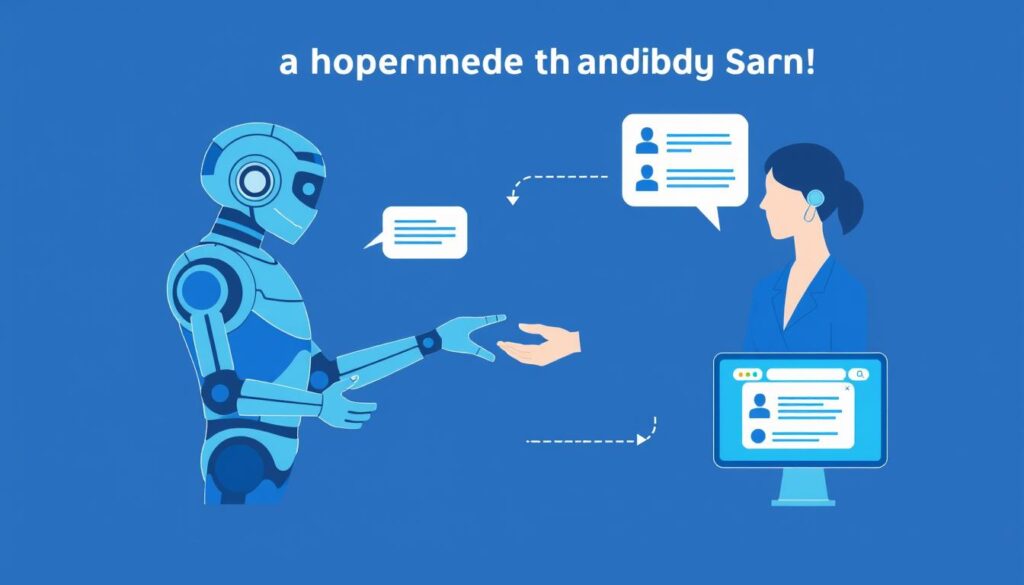The customer service landscape is undergoing a profound transformation. As consumer expectations for instant, personalized support continue to rise, businesses are turning to conversational artificial intelligence to meet these demands. This technology is no longer just a futuristic concept—it’s becoming an essential component of competitive customer experience strategies across industries and global markets.
With AI being on everyone’s minds these days, it’s hard to deny the impact it has on our daily lives and business operations. Customer service is no exception – and why should it be? Embracing conversational AI tools means less manual work for agents, always-on support for customers, and reduced operational costs for businesses – a clear win-win for everyone involved in the service ecosystem.
What is Conversational AI in Customer Service?
Conversational artificial intelligence (AI) is intelligent software that uses natural language processing (NLP), machine learning (ML), and other AI technologies to understand, process, and respond to human language in a natural, human-like way. In customer service, this technology powers solutions like chatbots, virtual assistants, and voice bots that can engage with customers across multiple channels.
Unlike traditional rule-based systems that follow rigid scripts, conversational AI can interpret context, detect sentiment, remember previous interactions, and continuously improve its responses over time. This creates more fluid, natural conversations that better meet customer needs while reducing the burden on human support teams.
Key Components of Conversational AI
Natural Language Processing (NLP)
NLP enables machines to understand human language by breaking down text or speech into components that computers can analyze. This includes natural language understanding (NLU), which interprets user intent, and natural language generation (NLG), which formulates human-like responses.
Machine Learning
Machine learning algorithms allow conversational AI systems to learn from each interaction, improving accuracy and relevance over time without explicit programming. The more conversations the system handles, the more refined its responses become.
Speech Recognition
For voice-based interactions, speech recognition technology converts spoken language into text that can be processed by the AI system, enabling voice assistants and IVR systems to understand customer queries.
Dialog Management
This component maintains the flow of conversation, tracking context across multiple exchanges to ensure coherent, meaningful interactions that don’t require customers to repeat information.
The Global Shift from Traditional to AI-Driven Customer Support
The customer service industry is experiencing a significant transition from conventional support channels to AI-powered solutions. According to Fortune Business Insights, the global conversational AI market is projected to grow from USD 12.24 billion in 2024 to USD 61.69 billion by 2032, exhibiting a CAGR of 22.4%.

This remarkable growth reflects how businesses worldwide are reimagining their customer service operations. Traditional support models centered around phone and email are being enhanced or replaced by omnichannel AI solutions that provide consistent experiences across websites, mobile apps, social media, and messaging platforms.
Key Drivers Behind This Shift
- Changing customer expectations for immediate, 24/7 service
- Increasing pressure to reduce operational costs while improving service quality
- Growing comfort with AI-powered interactions among consumers
- Advances in NLP and ML technologies making AI conversations more natural
- The need for scalable solutions that can handle fluctuating support volumes
According to the Zendesk Customer Experience Trends Report 2024, 51 percent of consumers now prefer interacting with bots when they want immediate service. This represents a significant shift in consumer attitudes compared to just a few years ago when chatbots were often viewed with skepticism.
Real-World Case Studies: Conversational AI Success Stories
The transformative impact of conversational AI is best illustrated through organizations that have successfully implemented these technologies. Here are several compelling examples from different industries:
Accor Plus: Hospitality Industry Transformation

Since implementing AI agents, the Accor Plus hospitality network has achieved remarkable results:
- 20% increase in customer satisfaction scores
- 352% improvement in response time
- 220% faster resolution time
- 24/7 support availability, including outside business hours
Their AI solution provides guests with self-service options for common inquiries like reservation details, amenity information, and loyalty program questions, freeing human staff to focus on delivering exceptional in-person experiences.
TaskRabbit: Scaling Support During Global Expansion

When TaskRabbit expanded internationally, their customer service volume surged by 60%, reaching 158,000 tickets monthly. By implementing conversational AI, they were able to:
- Automate 100% of first customer contacts
- Deflect 28% of tickets completely through AI resolution
- Maintain service quality despite the dramatic increase in volume
- Provide consistent support across multiple countries and time zones
TaskRabbit’s AI implementation demonstrates how conversational AI can enable global business expansion without proportional increases in support costs.
Unity: Significant Cost Savings Through AI Deflection

The 3D development platform Unity implemented AI to handle routine support inquiries, resulting in:
- $1.3 million in annual cost savings
- 83% improvement in first response time
- Higher developer satisfaction with support experiences
- More efficient allocation of specialized technical support resources
Unity’s case demonstrates the substantial ROI potential of conversational AI implementations when applied strategically to high-volume support scenarios.
Key Benefits of Conversational AI in Customer Service
Implementing conversational AI offers numerous advantages for businesses looking to enhance their customer service operations. Here are the most significant benefits:
24/7 Global Availability

According to Salesforce research, 77% of customers expect to interact with someone immediately when they contact a company. Conversational AI enables businesses to meet this expectation by providing:
- Round-the-clock support without staffing constraints
- Immediate responses to customer inquiries regardless of time zone
- Consistent service quality at all hours
- Reduced customer frustration from waiting for business hours
This always-on availability is particularly valuable for global businesses serving customers across multiple time zones and for industries where urgent support may be needed outside standard business hours.
Multilingual Support Capabilities
Advanced conversational AI systems can communicate in multiple languages, enabling businesses to provide native-language support to global customers without maintaining multilingual support teams. This capability:
- Removes language barriers in international customer service
- Creates more inclusive customer experiences
- Facilitates global business expansion
- Improves customer satisfaction in non-English-speaking markets
Personalized Customer Interactions

Modern conversational AI can deliver highly personalized experiences by leveraging customer data from integrated systems. This enables:
- Recommendations based on purchase history and preferences
- Proactive support based on customer behavior patterns
- Contextual awareness of previous interactions
- Tailored communication style based on customer profiles
For example, Fútbol Emotion implemented an AI agent that uses customer metadata to personalize interactions, creating more relevant and engaging support experiences.
Scalability During Peak Demand
One of the most significant advantages of conversational AI is its ability to handle fluctuating support volumes without degradation in service quality. This means:
- Consistent response times even during traffic spikes
- No need to overstaff for peak periods
- Ability to handle seasonal demand fluctuations
- Reduced customer abandonment during high-volume periods
This scalability is particularly valuable for retail businesses during holiday seasons, travel companies during booking peaks, and any organization that experiences predictable or unpredictable surges in customer inquiries.
Reduced Operational Costs

According to IBM’s research, AI-driven virtual agents can reduce labor costs significantly, leading to as much as a 30% decline in customer support expenses. These savings come from:
- Reduced staffing requirements for routine inquiries
- Lower cost per interaction compared to human agents
- Decreased training costs and employee turnover expenses
- More efficient use of specialized human resources
These cost benefits allow organizations to reinvest in improving other aspects of their customer experience or to achieve better financial performance without sacrificing service quality.
Addressing Implementation Challenges
While the benefits of conversational AI are compelling, organizations must navigate several challenges to ensure successful implementation:
Data Privacy and Security Concerns

According to the Achieving Customer Amazement Survey Report, 75% of consumers express concern about the privacy and security of their data when interacting with AI-based customer service technologies. To address these concerns, organizations should:
- Implement robust data encryption and security protocols
- Clearly communicate data usage policies to customers
- Comply with regional data protection regulations like GDPR and CCPA
- Provide options for customers to opt out of data collection
- Regularly audit AI systems for security vulnerabilities
Integration with Existing Systems
For conversational AI to deliver maximum value, it must seamlessly integrate with existing business systems. This integration can be challenging but is essential for:
- Accessing customer data from CRM systems
- Connecting to knowledge bases and support documentation
- Integrating with e-commerce and order management systems
- Working alongside human agents through the same support platforms
Organizations should prioritize AI solutions that offer robust API capabilities and pre-built integrations with common business systems.
Balancing Automation and Human Empathy

Finding the right balance between AI efficiency and human empathy remains one of the most significant challenges. According to SurveyMonkey’s report, 90% of people still prefer human customer service for complex or emotionally charged issues. Organizations can address this by:
- Clearly defining which types of inquiries should be handled by AI versus humans
- Creating seamless handoff processes from AI to human agents when needed
- Training AI to recognize emotional cues that indicate a human should intervene
- Using AI to augment human agents rather than replace them entirely
The most successful implementations view conversational AI as a complement to human support rather than a replacement.
Best Practices for Implementing Conversational AI
To maximize the benefits of conversational AI while minimizing potential pitfalls, organizations should follow these proven best practices:
Be Transparent with Customers
Customers appreciate knowing when they’re interacting with AI rather than a human agent. Organizations should:
- Clearly identify AI assistants as non-human at the start of interactions
- Explain the capabilities and limitations of the AI system
- Avoid designing AI to deliberately mislead customers about its nature
This transparency builds trust and sets appropriate expectations for the interaction.
Create Seamless Human Handoffs

When a conversation exceeds the AI’s capabilities, the transition to a human agent should be smooth and preserve context:
- Design clear escalation triggers based on complexity, sentiment, or explicit customer requests
- Transfer the full conversation history and customer context to the human agent
- Inform customers when they’re being transferred and provide estimated wait times
- Ensure human agents have the skills and information needed to resolve the escalated issue
Train Your AI with Relevant Data
The quality of your conversational AI is directly related to the quality of data used to train it:
- Use actual customer conversations from your business as training data
- Ensure your knowledge base is comprehensive and up-to-date
- Regularly update training data to reflect new products, policies, and common questions
- Include diverse language patterns and regional variations in training data
Continuously Monitor and Improve
Conversational AI implementation is not a one-time project but an ongoing process of refinement:
- Regularly review conversation logs to identify improvement opportunities
- Track key metrics like resolution rate, customer satisfaction, and escalation frequency
- Collect direct customer feedback about AI interactions
- Implement A/B testing to optimize conversation flows
This continuous improvement approach ensures your conversational AI becomes more effective over time.
Future Trends in Conversational AI for Customer Service

The field of conversational AI continues to evolve rapidly. Here are the key trends that will shape its future in customer service:
Emotion-Aware AI
Next-generation conversational AI will become increasingly adept at recognizing and responding to customer emotions:
- Sentiment analysis to detect frustration, confusion, or satisfaction
- Adaptive responses based on emotional context
- Proactive escalation to humans for emotionally charged situations
- More nuanced understanding of tone and intent
This emotional intelligence will help bridge the empathy gap that currently exists between AI and human agents.
Hyper-Personalization via Generative AI
Advances in generative AI are enabling more personalized and contextually relevant conversations:
- Dynamic response generation tailored to individual customer profiles
- Personalized recommendations based on comprehensive customer data
- Adaptive conversation styles matching customer preferences
- More natural, less scripted interactions
According to the Zendesk report, 48% of customers already say it’s becoming harder to tell the difference between AI and human service representatives, and this trend will accelerate with generative AI advancements.
Seamless Human-AI Collaboration

Rather than replacing humans, future conversational AI will work more collaboratively with support teams:
- AI copilots that assist agents in real-time during customer interactions
- Intelligent routing that matches customers with the right combination of AI and human support
- Automated post-interaction tasks and follow-ups
- Continuous learning from human agent interventions
This collaborative approach will maximize the strengths of both AI efficiency and human empathy.
Voice-First Experiences
As voice recognition technology improves, voice-based conversational AI will become more prevalent:
- More natural voice interactions with fewer misunderstandings
- Better handling of accents, dialects, and speech patterns
- Multimodal experiences combining voice and visual elements
- Voice biometrics for secure authentication
This trend will make conversational AI more accessible to all customer segments, including those who prefer speaking to typing.
Conclusion: The Path Forward with Conversational AI
Conversational AI is fundamentally transforming customer service worldwide, creating opportunities for businesses to deliver better experiences while controlling costs. As we’ve explored throughout this article, the technology offers compelling benefits in terms of availability, personalization, scalability, and efficiency.
However, successful implementation requires thoughtful planning, a clear understanding of which interactions are appropriate for AI versus human agents, and a commitment to continuous improvement. Organizations that approach conversational AI as a complement to human support—rather than a replacement—will achieve the best results.
As you consider implementing or expanding conversational AI in your customer service operations, focus on creating experiences that balance technological efficiency with the human touch that customers still value. By following the best practices outlined in this article and staying attuned to emerging trends, you can position your organization at the forefront of this customer service revolution.
Frequently Asked Questions About Conversational AI in Customer Service
What’s the difference between chatbots and conversational AI?
While chatbots are a type of conversational AI, not all chatbots use advanced AI. Traditional chatbots follow pre-programmed rules and decision trees with limited ability to understand natural language. Conversational AI, by contrast, uses natural language processing and machine learning to understand intent, context, and nuance in human language, enabling more flexible and natural interactions that improve over time.
Will conversational AI replace human customer service agents?
While conversational AI can handle many routine inquiries, it’s unlikely to completely replace human agents. Research consistently shows that customers prefer human interaction for complex, emotional, or high-stakes issues. The most effective approach is using AI to handle routine matters while enabling human agents to focus on situations where empathy, creativity, and judgment are required. This collaborative model enhances overall service quality while controlling costs.
How do customers really feel about interacting with AI for customer service?
Customer attitudes toward AI in customer service are evolving. According to the Zendesk Customer Experience Trends Report 2024, 51% of consumers now prefer interacting with bots when seeking immediate service. However, preferences vary by context—customers are generally comfortable with AI for simple inquiries but prefer humans for complex issues. Transparency about when customers are interacting with AI and providing easy escalation paths to human agents are key factors in customer acceptance.
What types of customer service tasks are best suited for conversational AI?
Conversational AI excels at handling routine, repetitive tasks such as answering frequently asked questions, providing order status updates, processing simple returns and exchanges, collecting customer information, scheduling appointments, and triaging support requests. These tasks typically follow predictable patterns and don’t require complex judgment or emotional intelligence, making them ideal candidates for automation.
Control Support Costs with AI
Make great customer service automatic. Our free playbook explains how artificial intelligence helps you save time and money while improving customer satisfaction.
Ready to Transform Your Customer Service with AI?
Our experts can help you implement conversational AI that balances automation with the human touch your customers expect. Schedule a consultation to discuss your specific needs.
Start Your Conversational AI Journey Today
Download our comprehensive guide to implementing conversational AI in customer service. Learn how to select the right solution, prepare your team, and measure success.







